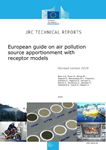Source Apportionment (SA) is the practice of deriving information about pollution sources and the amount they contribute to ambient air pollution levels. This task can be accomplished using emission inventories, source-oriented models and receptor-oriented models (or simply receptor models).
Receptor SA models (RM) rely on mass balance analysis and statistical evaluation of chemical data obtained at the receptor site (typically PM). RMs source apportionment encompasses many tools ranging from simple techniques based on elementary mathematical calculations and basic physical assumptions (e.g. enrichment factor analysis) to complex models with pre- and post-data processing and user-friendly interfaces. Although all such tools deal with measured pollutant concentrations at the receptor site, the type of the input data may vary considerably.
Source oriented SA models (SM) simulate the distribution of concentrations of airborne pollutants over a given area starting from emission data and then simulating the processes affecting the pollutants during their lifetime in the atmosphere. This can be achieved in different ways, depending on the type of model employed and the technique that is then used to assess the contributions.
SPECIEUROPE is an asset for the community of experts working on source apportionment to achieve better definition of sources and therefore more reliable source attribution.
The database contains the chemical composition of particulate matter emission sources reported in the scientific literature and reports drafted by competent authorities.
The continuous development of SPECIEUROPE requires the support of all the European experts working in the field. For that reason, contributing with source profile data is very much welcomed and will be acknowledged in the dedicated page of the website.
For further information or for any contributions to the database do not hesitate to contact us
SPECIEUROPE was developed by D. Pernigotti, C.A. Belis and L. Spano.
DeltaSA is an on-line tool to assess source apportionment model outputs in line with the CEN Technical Specification 17458:2020. It works in two different modes.
The first is the source chemical profiles similarity test (CPS) accomplished by comparing those obtained by the user with more than one thousand PM10/PM2.5 source measured chemical profiles from the online SPECIATE (US-EPA) and SPECIEUROPE repositories. This configuration is intended to support practitioners in the identification of factors during the execution of factor analytical tools.
The second mode consists in a complete test of the model performance (MP) using a testing dataset and reference values generated in the framework of inter-comparison exercises organized by the European Commission- JRC.
DeltaSA was developed by D. Pernigotti and C.A. Belis.
In order to improve the comparability of results from different approaches and to constrain the output's uncertainty, in 2010 the JRC launched an initiative for the harmonisation of source apportionment methodologies, starting with receptor models, in collaboration with the European networks in the field of air quality modelling (FAIRMODE) and measurements (AQUILA). The work was later on extended and continued under FAIRMODE WG3 (now WG1) and CEN Technical Committee 264WG 44.
The activities carried were:
- review of the methodologies used in Europe for source identification,
- intercomparison exercises for the quantitative assessment of the performance of SA models,
- drafting European Common Protocols for SA with receptor models;
A collection of publications resulting from these and other activities concerning source apportionment is available on this website

This report contains a guide and a European harmonised protocol prepared within the framework of the source apportionment working group of the Forum for Air Quality Modelling in Europe (FAIRMODE).
It has been initiated as a JRC initiative for the harmonisation of source apportionment with receptor models, in collaboration with FAIRMODE as well as with the European networks in the field of air quality measurements (AQUILA), and then further with the European COLOSSAL (Chemical On-Line cOmpoSition and Source Apportionment of fine aerosol) COST action. The JRC initiative also included a review of the methodologies used in Europe for source identification and intercomparison exercises for the quantitative assessment of the performance of source apportionment models.

Particulate matter is one of the most critical atmospheric pollutants, in terms of impact on human health, in Europe and worldwide. Understanding the role of the different sources and processes leading to its formation and transformation/evolution is essential to support the development of abatement strategies.
The present guide, developed under the Forum for Air Quality Modelling (FAIRMODE), provides an overview, illustrates the methodologies and formulates recommendations for the application of air quality source oriented models (SMs) in estimating contributions of sources to particulate matter.
It also describes the potential of SM techniques and critically discusses the advantages and the limitations of applying simultaneously receptor models (RM) and source oriented models (SM) in source apportionment (SA) studies.
